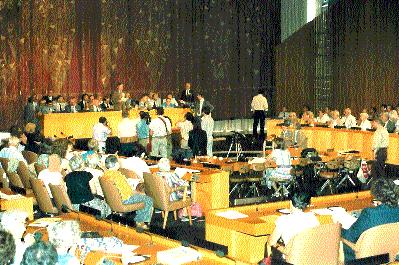Chapter 1: The Anti-Imperialist League 1898-1902
Pages 3 - 4
Chapter 2: The People's Council 1917-1919
Pages 5 - 6 - 7
Chapter 3: The American League Against War and Fascism and the Emergency Peace Campaign 1933-1939
Pages 8 - 9 - 10
Chapter 4: The Progressive Citizens of America 1946-1948
Pages 11-12
Chapter 5: The "Mobes" against the Vietnam War 1966-1970
Pages 13-14
Chapter 6: The Nuclear Freeze Movement and People-to-People Diplomacy 1980-1990
Pages 15-16-17-18
Chapter 7: Global Movement for a Culture of Peace 2000-
Pages 19-20-21
Chapter 8: The Root Causes of War
Pages 22-23-24-25-26-27
Chapter 9: The Future of the Peace Movement
Pages 28-29-30-31
Acknowledgements
Page 37
(continued from previous page)
Thousands of people took advantage of people-to-people exchange between the U.S. and the Soviet Union, breaking down the enemy images that made possible the Cold War on both sides. As an activist with one of these exchange programs, the National Council for American-Soviet Friendship, I made many trips to the Soviet Union and hosted many Soviet groups in the U.S. It was during one of the people-to-people exchanges in 1986, a cruise down the Mississippi River by Soviet and U.S. peace activists (sponsored by Promoting Enduring Peace), that a joint U.S.-Soviet peace petition was drafted and signed: the People's Peace Appeal. Over the course of 1986-87, the People's Peace Appeal was signed by 500,000 Americans and millions of Soviets (see note 13 for details).
The basement of our office in New York was filled with cardboard cartons of American signatures that finally had to be thrown away when we moved the office. As for the Soviet figure of 40 million signatures, provided to us in July 1987, this is quite plausible as entire schools and factories were mobilized. On the basis of the Peoples Peace Appeal we started a pairing project of schools, trade unions, cities and towns between the two countries which was just getting underway in 1988, but never worked out, because by then the Soviet Union had started to disintegrate.

|
| Figure 8. Signing of Peoples Peace Appeal at United Nations headquarters in 1986 |
Since people-to-people exchange directly challenged the image of the enemy, the Peoples Peace Appeal was considered as treasonous by some (See US State Department, Soviet Influence Activities 1986-1987, pages 81 and 85). In this respect, it is not so surprising that many of us who were engaged in this movement found ourselves harassed by the FBI and other U.S. government agencies as well as by anti-communists in the U.S.
A strong case can be made that the Nuclear Freeze Movement, the strong movement for peace in the Soviet Union and other Eastern European countries and the many initiatives for people-to-people diplomacy made the difference in the avoidance of a nuclear war during the 1980's and helped ensure that the demise of the Soviet empire was not bathed in blood. Gorbachev, who was greatly influenced by what he called "citizen diplomacy", stated later that "my credo was: We need radical reform without bloodshed, without violence." In fact, the fall of the Berlin Wall and the transition of Eastern Europe, including the Soviet Union from the power of the Communist Party to a "savage capitalist" system was accomplished with a minimum of overt violence. The violence that did occur, in Afghanistan and Chechnya, was aided and abetted by the Central Intelligence Agency. The U.S. role in Afghanistan is well-known, including support for Bin Laden and other Mujahadeen, while that for Chechnya is less well known. I knew about it because at least one of my fellow Fulbright scholars in Soviet Georgia in 1980 boasted of running guns to Grozny for the CIA.
Despite the end of the Cold War and the transition of the socialist countries to open capitalist economies in relation with the NATO countries, there was no end to violence and war. Where was the American Peace Movement? During the Gulf War in 1991 anti-war mobilization started to develop very quickly in churches, trade unions and the U.S. Congress, but the war was declared over within a few weeks, thus defusing the further development of a peace movement. In fact, it is probable that one reason the war was ended so quickly was that the U.S. government feared the development of another movement as large and powerful as those against the Vietnam and Cold Wars. Following the Gulf War military budgets diminished somewhat for a few years, but by the end of the 90's they were on the increase again, accelerating with the so-called "War on Terrorism" in 2001.
 |
 |
 |